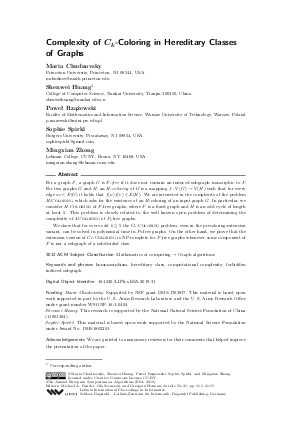@InProceedings{chudnovsky_et_al:LIPIcs.ESA.2019.31,
author = {Chudnovsky, Maria and Huang, Shenwei and Rz\k{a}\.{z}ewski, Pawe{\l} and Spirkl, Sophie and Zhong, Mingxian},
title = {{Complexity of C\underlinek-Coloring in Hereditary Classes of Graphs}},
booktitle = {27th Annual European Symposium on Algorithms (ESA 2019)},
pages = {31:1--31:15},
series = {Leibniz International Proceedings in Informatics (LIPIcs)},
ISBN = {978-3-95977-124-5},
ISSN = {1868-8969},
year = {2019},
volume = {144},
editor = {Bender, Michael A. and Svensson, Ola and Herman, Grzegorz},
publisher = {Schloss Dagstuhl -- Leibniz-Zentrum f{\"u}r Informatik},
address = {Dagstuhl, Germany},
URL = {https://drops.dagstuhl.de/entities/document/10.4230/LIPIcs.ESA.2019.31},
URN = {urn:nbn:de:0030-drops-111529},
doi = {10.4230/LIPIcs.ESA.2019.31},
annote = {Keywords: homomorphism, hereditary class, computational complexity, forbidden induced subgraph}
}

 Creative Commons Attribution 3.0 Unported license
Creative Commons Attribution 3.0 Unported license



